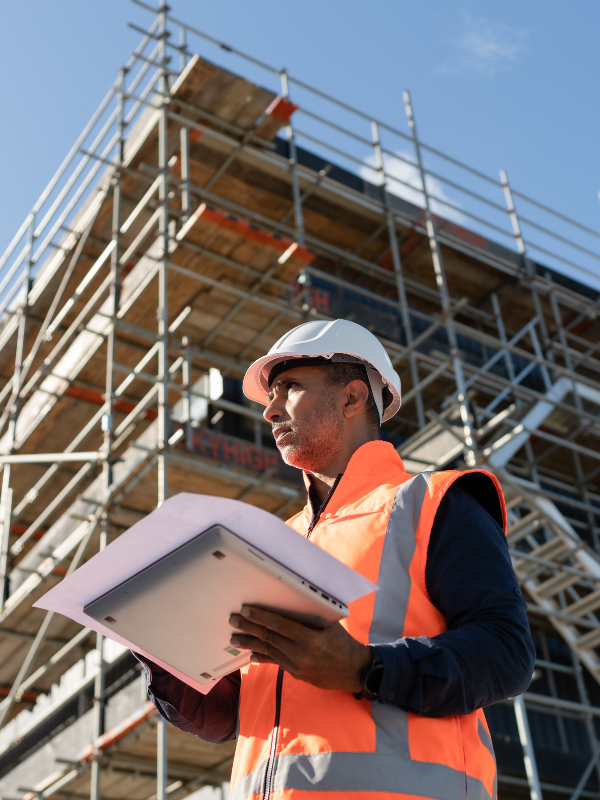Explore the importance of safety compliance in KSA’s construction sector, including regulations, best practices, and how to avoid costly penalties.

The construction sector in Saudi Arabia is booming, with mega projects like NEOM, The Line, and Qiddiya leading the way under Vision 2030. However, this growth brings a critical responsibility: ensuring worker safety and compliance with regulations. For construction firms operating in the Kingdom, safety isn’t just a legal requirement—it’s a business essential.
Ignoring safety standards can lead to severe consequences, including project delays, financial penalties, damaged reputation, and even loss of life. This blog will explore why safety compliance is so vital, what regulations firms must follow, and how to build a culture of safety on your construction sites.
1. Understanding Saudi Arabia’s Safety Regulations
The Saudi Ministry of Human Resources and Social Development (HRSD) and the Ministry of Municipal and Rural Affairs and Housing (MOMRAH) enforce a robust set of safety laws aimed at protecting workers and ensuring construction quality.
Some key safety regulations include:
- Personal Protective Equipment (PPE) mandates
- Fall prevention systems for high-rise and scaffold work
- Site risk assessments and hazard identification
- First-aid facilities and emergency plans
- Health and safety training for all site workers
Failure to comply with these regulations can result in hefty fines, suspension of operations, or even permanent blacklisting from future government projects.
2. Common Safety Challenges in the Construction Sector
Construction is inherently high-risk. In Saudi Arabia, the extreme climate, multilingual workforce, and high-pressure project timelines increase the risks even more.
Some common safety challenges include:
- Heat stress and dehydration
- Language barriers affecting communication
- Inadequate training on new equipment or procedures
- Lack of emergency preparedness
- Poor documentation or absence of safety audits
Addressing these issues requires a proactive approach and consistent monitoring.
3. Benefits of Strong Safety Compliance
Safety compliance isn’t just about avoiding fines. It brings many long-term benefits:
- Reduced downtime from accidents and investigations
- Increased worker morale and productivity
- Lower insurance premiums
- Fewer legal claims and liabilities
- Improved company reputation with clients and authorities
Firms with good safety records are often prioritized for contracts, especially on high-profile projects like those under Vision 2030.
4. Implementing Safety Best Practices
Creating a safe construction environment requires more than just rules. Here are practical steps to ensure compliance:
- Conduct thorough safety orientation for all new hires
- Regularly inspect and maintain equipment
- Install proper signage across the site (bilingual if needed)
- Assign safety officers on each site
- Create a safety checklist for daily site reviews
- Hold weekly toolbox talks and monthly audits
Investing in digital tools like wearable sensors, drone inspections, and real-time safety dashboards can also streamline safety enforcement.
5. Case Study: A Safety-First Approach in Riyadh
A leading construction firm working on a commercial tower in Riyadh implemented a digital safety compliance platform integrated with worker ID tags. This system:
- Tracked worker movement to avoid high-risk zones
- Alerted supervisors to unsafe practices
- Logged daily compliance reports
The result? Zero serious injuries, higher efficiency, and early project completion.
This real-world success highlights how modern technology and commitment to safety go hand in hand.
6. Training and Worker Empowerment
Effective training is the backbone of any safety strategy. Construction firms in KSA are increasingly conducting:
- Hands-on safety workshops
- Scenario-based drills
- Heat safety programs
- Language-specific safety modules
Moreover, empowering workers to report hazards without fear of retaliation builds a strong safety culture from the ground up.
7. Preparing for Safety Audits and Certifications
Government and private clients may require proof of safety compliance through audits or certifications. Here’s how to stay ready:
- Keep updated logs of safety training and incidents
- Conduct internal audits regularly
- Ensure all equipment is up to regulatory standards
- Apply for certifications like ISO 45001 (Occupational Health and Safety Management System)
Being audit-ready improves credibility and helps win future projects.
8. Cost of Non-Compliance: What Happens When Safety Fails?
The consequences of neglecting safety are severe:
- Fines ranging from SAR 10,000 to over SAR 100,000
- Loss of business licenses
- Public blacklisting by government authorities
- Loss of life and irreversible reputational damage
In worst-case scenarios, firms may be banned from future projects or face criminal charges.
Conclusion: Building a Safer Future for Saudi Construction
As Saudi Arabia pushes toward Vision 2030, the construction industry must rise to the occasion with world-class safety standards. Whether you’re a small contractor or a major developer, prioritizing safety is not just good practice—it’s a necessity for sustainable success.
Firms that embed safety into their culture will enjoy smoother operations, higher worker retention, and a trusted name in a competitive market.

